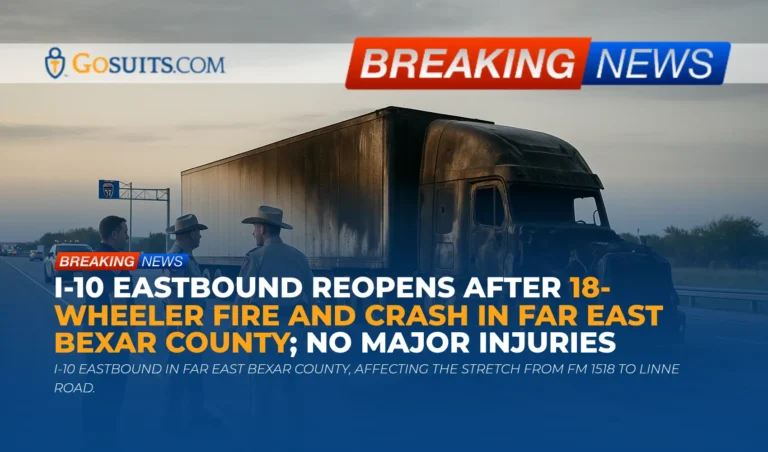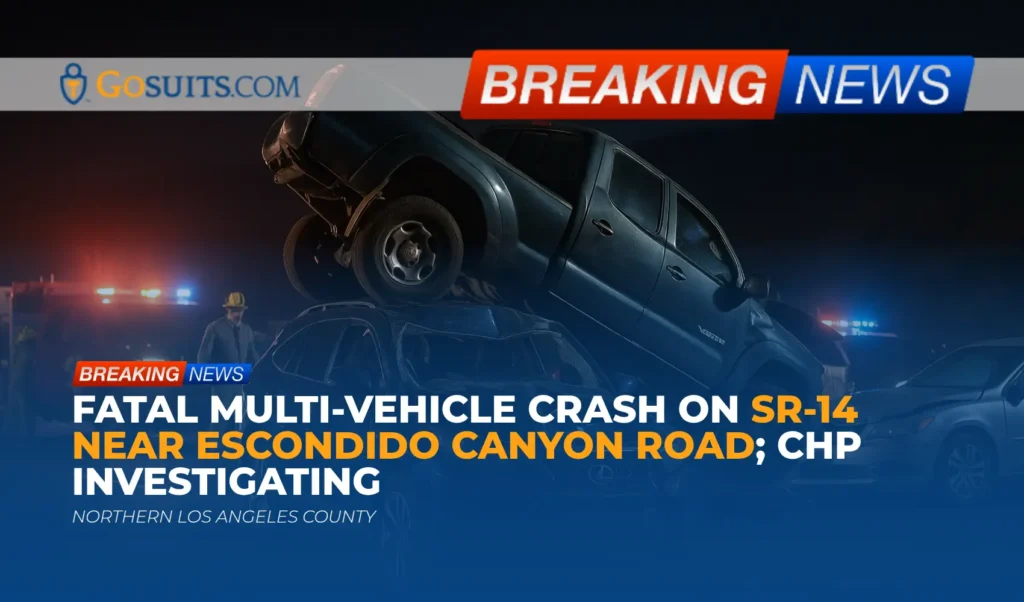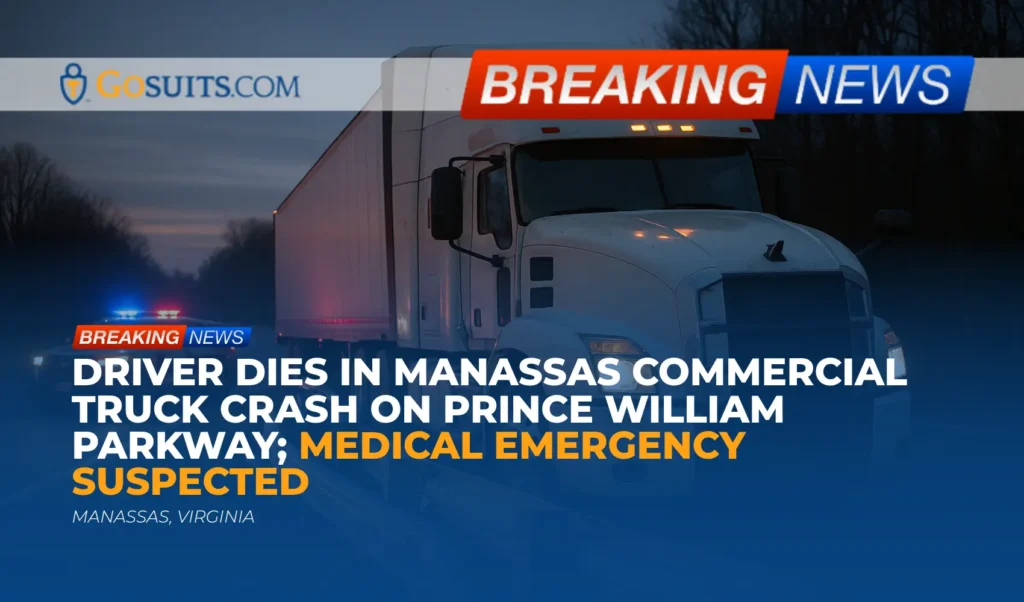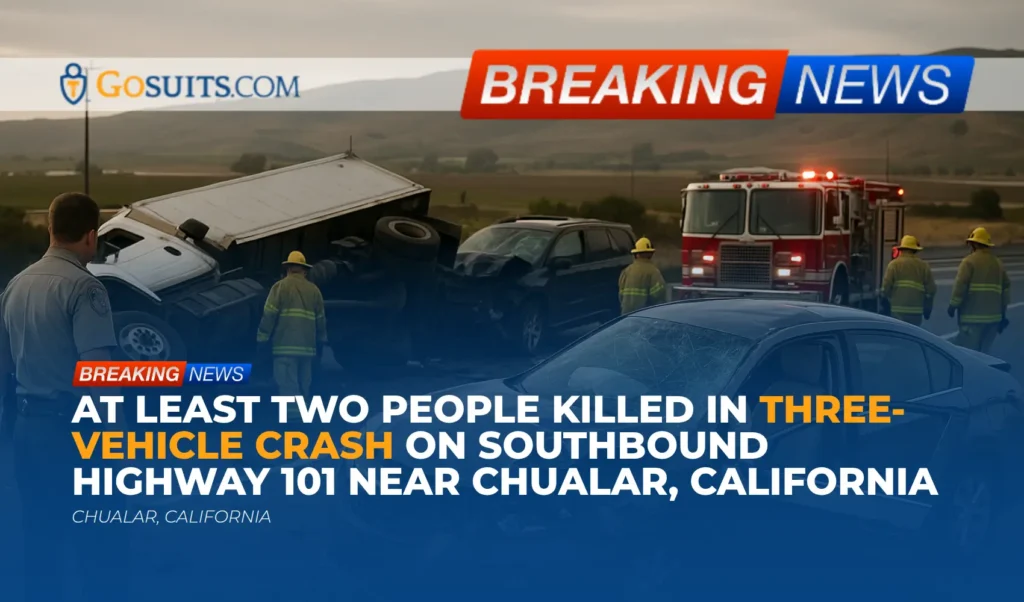- What We Know About the I-10 Eastbound Crash in Far East Bexar County
- Timeline and Location Details
- Law Enforcement and Agency Updates
- Known Injuries and Property Damage
- Why 18-Wheeler Fires Happen: General Safety Context
- Legal Rights After a Highway Truck Crash in Texas
- How to Get Official Records and Information
- Practical Steps After a Major Highway Closure and Crash
- Truck Crash Trends and Safety Data
- Deadlines That Can Affect Claims in Texas
- Why Acting Promptly Matters
- Commentary from Gosuits Bexar County, Texas Personal Injury Attorney
What We Know About the I-10 Eastbound Crash in Far East Bexar County
Early Thursday morning, a two-vehicle collision on eastbound Interstate 10 in far east Bexar County led to an hours-long closure and major traffic delays. According to traffic maps referenced by local reporting, an 18-wheeler was involved and caught fire. The driver escaped. Authorities reported no significant injuries. The incident was first reported around midnight, and the roadway reopened after the scene cleared at approximately 5:30 a.m. This summary reflects publicly reported information available as of the morning of October 9, 2025.
Timeline and Location Details
Based on the information released:
- Time of initial reports: Shortly after midnight.
- Duration of closure: Several hours, with clearance around 5:30 a.m.
- Location: I-10 eastbound in far east Bexar County, affecting the stretch from FM 1518 to Linne Road.
- Traffic impact: Backups reportedly extended westward nearly to Loop 1604 for hours.
- Involved vehicles: Two vehicles, including a tractor-trailer that ignited.
This corridor carries a mix of commuter and freight traffic, and any closure in this area can quickly ripple into substantial regional delays, especially when it occurs overnight and into the morning rush.
Law Enforcement and Agency Updates
Officials indicated the following developments:
- Bexar County Sheriff’s Office reported a two-vehicle collision and confirmed the truck fire, noting the driver escaped.
- Texas Department of Transportation reported via spokesperson that the scene was cleared by 5:30 a.m., allowing eastbound lanes to reopen.
At the time of reporting, this remained a developing situation and authorities had not released detailed causation or fault information. In Texas, when a crash involves injury, fatality, or sufficient property damage, officers generally complete a Texas Peace Officer’s Crash Report (CR-3) that can later be requested by eligible parties. The reporting and disclosure rules are set by the Texas Transportation Code, including officer reporting duties and who can obtain crash reports. See Texas Transportation Code sections 550.062 and 550.065.
Known Injuries and Property Damage
Authorities stated there were no significant injuries reported. Even when serious bodily injuries are not immediately apparent, crashes involving heavy vehicles and fires can still lead to:
- Delayed-onset symptoms: Soft tissue injuries, mild concussions, and smoke inhalation effects may not show immediately.
- Property damage: Burn damage to the tractor or trailer, cargo loss, and roadway infrastructure impacts.
- Secondary impacts: Towing, storage fees, lost work time due to the closure, and vehicle rental costs.
If anyone later experiences pain, dizziness, headaches, or respiratory symptoms after exposure to smoke or a collision, prompt medical evaluation is appropriate. Documentation from medical visits can be important for any insurance claims that follow.
Why 18-Wheeler Fires Happen: General Safety Context
Without speculating about the cause in this specific crash, truck fires can happen for several reasons. Common factors include:
- Mechanical or electrical faults: Overheated brakes, tire failures that spark, or electrical shorts.
- Fuel or fluid ignition: Flammable fluids contacting hot surfaces after a collision or component failure.
- Cargo risks: Certain loads increase fire risk if packaging is compromised.
- Crash dynamics: A forceful impact can rupture lines, damage battery systems, or compromise insulation.
Commercial drivers and carriers must follow federal safety rules, including hours-of-service limits that are designed to reduce fatigue, a known crash contributor. See the Federal Motor Carrier Safety Administration’s summary of hours-of-service rules at FMCSA. Proper maintenance, inspections, and securement of cargo further reduce risk.
Legal Rights After a Highway Truck Crash in Texas
Potential Civil Liability Paths
In Texas, liability for a two-vehicle collision generally turns on whether a driver or company did not use reasonable care. Potential civil fault, depending on evidence, may involve:
- Driver negligence: Speeding, distracted driving, unsafe lane changes, or fatigue.
- Carrier negligence: Poor maintenance, inadequate training, unrealistic dispatch schedules, or negligent hiring and supervision.
- Product or maintenance issues: Defective components or negligent repairs that contribute to a fire or loss of control.
- Roadway conditions: If a roadway defect, inadequate signage, or unsafe work zone contributed, claims procedures may differ for government entities.
If a government entity is potentially involved due to roadway conditions, Texas imposes strict notice requirements under the Texas Tort Claims Act. Potential claimants typically must provide notice within six months, and some local governments require shorter notice periods. See Texas Civil Practice and Remedies Code section 101.101.
Preservation of Evidence Specific to 18-Wheelers
Critical evidence in truck cases can disappear quickly due to routine business practices. Timely preservation can include:
- Electronic data: Engine control module data, telematics, and dash camera footage.
- Hours-of-service and ELD records: Carriers must keep certain hours-of-service and supporting documents for defined retention periods under federal regulations. See FMCSA rules in 49 CFR Part 395, available via the eCFR.
- Driver qualification and maintenance files: Carriers maintain driver and vehicle records. See 49 CFR Part 391 for driver qualification file requirements in the eCFR.
- Cargo documentation: Bills of lading, weight tickets, and shipper communications can be relevant when cargo or weight distribution is at issue.
Sending prompt written preservation requests can help ensure data is not overwritten or discarded. Because what is said early to an insurer can be used later, it is wise to consult an attorney before speaking with any insurance company or carrier representatives.
Insurance Coverage Considerations
Commercial carriers are required to carry minimum liability insurance under federal rules, with higher limits for hazardous materials. See 49 CFR Part 387 at the eCFR. Other potential policies may include cargo coverage, trailer interchange, and various endorsements. Private motorists typically look to their own collision and uninsured or underinsured motorist coverage for vehicle repairs and, where applicable, injuries. When beginning any claim process, contacting an attorney first can help protect rights and guide communications.
How to Get Official Records and Information

Texas Peace Officer’s Crash Report (CR-3)
In Texas, investigating officers file a CR-3 crash report with TxDOT when a crash involves injury, death, or sufficient property damage. This report often includes diagrams, contributing factors, and road conditions. Eligible persons can purchase a copy through TxDOT’s Crash Records Information System. See TxDOT’s CRIS purchase portal at TxDOT CRIS. Access to the report and certain data is governed by Texas Transportation Code section 550.065.
911 Calls, Dispatch Logs, and Body or Dash Camera Video
Audio recordings of 911 calls, computer-aided dispatch logs, and certain videos may be obtainable through public information requests under the Texas Public Information Act, with limitations for privacy and law enforcement exceptions. See Texas Government Code Chapter 552. Requests can be made to the investigating law enforcement agency. Be specific about date, time, location, and nature of the records to streamline processing.
Autopsy and Medical Examiner Records in Fatal Cases
While no fatalities were reported in this incident, families confronting fatal crashes typically coordinate with the county medical examiner for autopsy information and final reports. The Texas medical examiner system is established in the Texas Code of Criminal Procedure article 49.25. Availability of reports and images may be subject to the Public Information Act and other statute-based exceptions. In Bexar County, the medical examiner’s office handles such matters and can advise families on next steps and documentation needed.
Roadway and Traffic Camera Footage
In and around San Antonio, TxDOT operates traffic management cameras and message boards as part of intelligent transportation systems. In some cases, short-term footage or still images may be available through records requests to TxDOT or local agencies. Availability and retention vary, and some cameras only provide live feeds without recording. Requests can be made under the Public Information Act noted above.
Fire Department Incident Reports
When a truck catches fire, local fire departments generate incident records. These reports can document arrival times, suppression efforts, suspected ignition sources, and hazardous material concerns. Requests are usually routed to the fire department’s records division, often subject to the same Public Information Act rules. Provide exact location, date, and time to assist the search.
Practical Steps After a Major Highway Closure and Crash
If a person was affected by a crash or its aftermath, there are practical steps that can make a significant difference. The details below are general information, not legal advice, but reflect common best practices seen in highway crash matters:
- Prioritize safety and health: Seek medical evaluation even if symptoms are mild or delayed, particularly after smoke exposure or a jarring impact.
- Document everything: Keep photographs, dash camera files, tow and storage receipts, rental car invoices, and missed work records.
- Request official records: Obtain the CR-3 crash report from TxDOT when it is available. Note the agency case number for cross-referencing.
- Preserve vehicle evidence: Before authorizing repairs or disposal, consider whether an inspection is warranted. For commercial vehicles, ECM data and logs can be crucial.
- Be mindful in insurance communications: Contact an attorney first. What is said to an insurer, even your own, can be recorded and used later. Provide only accurate, necessary information after understanding your rights.
- Follow Texas traffic laws near crash scenes: Texas requires drivers to move over or slow down for stopped emergency and TxDOT vehicles when safe to do so. See Transportation Code section 545.157.
Truck Crash Trends and Safety Data
Even where immediate injuries are minimal, an 18-wheeler fire on a busy interstate highlights broader safety realities. A few data points provide context:
- National fatality totals involving large trucks: In recent annual data, thousands of lives are lost in crashes involving large trucks in the United States. NHTSA’s Traffic Safety Facts report for 2022 notes fatalities in crashes involving large trucks nationwide. See NHTSA’s resources at NHTSA CrashStats.
- Weekday and daytime prevalence: Many large-truck fatal crashes occur on weekdays due to the nature of commercial operations. NHTSA provides breakdowns by time of day, roadway type, and other factors at the link above.
- Texas crash reporting: Texas centralizes crash records with TxDOT, making CR-3 reports a key source for understanding patterns and causes statewide. Access information is available through TxDOT CRIS.
The combination of heavy vehicle mass, long stopping distances, and high-speed corridors means that even non-fatal incidents can be dangerous and disruptive. Maintenance discipline, alert driving, and compliance with federal and state safety rules are essential defenses.
Deadlines That Can Affect Claims in Texas
Texas imposes deadlines that can affect civil claims:
- Personal injury and property damage limitations: In many cases, a two-year statute of limitations applies. See Texas Civil Practice and Remedies Code section 16.003.
- Government notice: If a claim may involve a state or local governmental unit due to roadway conditions or emergency response issues, notice requirements apply. See Texas Civil Practice and Remedies Code section 101.101.
- Evidence retention windows: Commercial carriers have retention timelines for certain records. Prompt action can be necessary to prevent loss of logs, electronic data, or video.
Because these timelines can be complex and fact dependent, early consultations are often helpful to understand which deadlines apply, especially where multiple vehicles, corporate actors, or public entities are involved.

Why Acting Promptly Matters
This section explains why timely action can be critical after a highway truck crash, even where early reports indicate no significant injuries:
- Evidence can be lost: Electronic data, dash camera footage, and third-party video are often overwritten within days or weeks. Taking steps quickly increases the chance this material is preserved.
- Records requests take time: Agencies frequently require processing time under the Public Information Act. Early requests help ensure you receive documents when you need them.
- Medical documentation: Same-day or next-day medical notes carry more weight than delayed visits when explaining symptoms to insurers.
- Insurance positioning: Insurers may contact involved individuals early. Speaking before understanding your rights can create statements that complicate fair handling later. Consult an attorney first, then decide what to say and when.
- Deadlines start running immediately: From general statutes of limitations to government notice requirements, the clock can start the day of the crash. Knowing which deadlines apply to your situation helps avoid forfeiting claims.
- Financial impacts mount: Storage fees, towing charges, and rental costs accumulate. Early coordination on property damage can help reduce unnecessary expenses.
The benefit of early, informed action is clarity. It allows a plan for health care, documentation, evidence preservation, and insurance steps, which can improve the path to resolution later.
Commentary from Gosuits Bexar County, Texas Personal Injury Attorney
Our thoughts are with everyone affected by the overnight closure and the drivers involved in the fire and collision. Incidents like this are frightening, even when early reports indicate no significant injuries. This commentary is offered for educational purposes and general information so the community understands what typically follows a highway crash involving a commercial truck.
From a civil injury perspective, two-vehicle crashes that include an 18-wheeler raise specific questions about cause, mechanical condition, and compliance with safety rules. The fact that a truck ignited does not itself prove fault, but it signals the need for a careful look at maintenance, component failure, cargo securement, and impact forces. The core tasks are methodical: obtain the CR-3 crash report, preserve any electronic data and video, review dispatch and hours-of-service compliance, and examine whether roadway conditions contributed. These steps help assemble an accurate picture of what happened and why.
Insurance companies and large corporate carriers manage claims daily. They are familiar with the process, timelines, and documents, and they often reach out quickly. People who are shaken by an incident naturally want to be helpful, but early recorded statements or broad medical releases can work against a fair evaluation later. That is why understanding your rights before speaking with any insurer can be so important. Knowledge levels the playing field, helps keep the focus on facts and documents, and prevents avoidable missteps.
Free consultations can be a practical way to understand options and timeframes without pressure. They allow a person to ask about evidence preservation, medical documentation, estimated timelines for CR-3 availability, and the pros and cons of contacting insurers. They also provide space to discuss whether specialized inspections or letters requesting preservation are warranted. No single approach fits every crash, but an informed plan typically produces better outcomes.
However the investigation unfolds, we hope everyone on I-10 this morning made it home safely, and that the drivers and families involved have the support they need to move forward.






